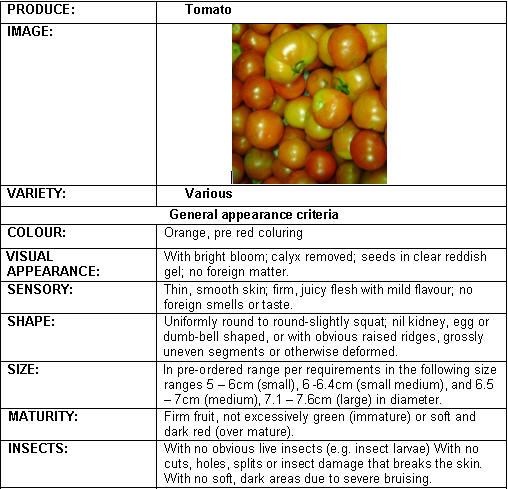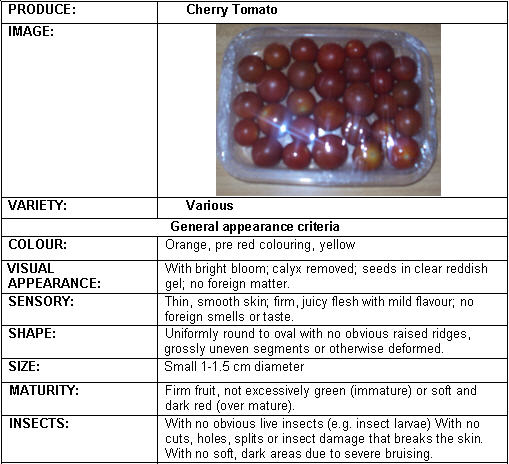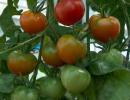 |
Tomato
Scientific name:
Lycopersicon esculentum
Family:
Solanales: Solanaceae
Local names:
Nyanya (Swahili)
Pests and Diseases: African bollworm
Anthracnose
Aphids
Bacterial canker
Bacterial spot
Bacterial wilt
Blossom-end rot
Broomrape
Cabbage looper
Cutworms
Damping-off diseases
Dodder
Early blight
Fusarium wilt
Late blight
Leaf mould
Leafmining flies (leafminers)
Powdery mildew
Root-knot nematodes
Sedges
Spider mites
Thrips
Tomato mirid bug
Tomato mosaic virus
Tomato russet mite
Tomato spotted wilt virus
Tomato Yellow Leaf Curl Virus Disease (TYLCV)
Weeds
Whiteflies
Armyworm, Black speck
|
 |
| Geographical Distribution of Tomato in Africa |
Tomatoes are one of the most widely cultivated vegetable crops in Africa. They are grown for home consumption in the backyard of almost every homestead across sub-Saharan Africa. They are important source of vitamins and an important cash crop for both smallholders and medium-scale commercial farmers. Tomatoes acting as taste enhancers in food are always in high demand both for fresh consumption and processing.
Tomato yields in smallholder cropping systems in the region are generally far below the potential of the crop. Average yields as low as 7 tons/ha have been reported from Tanzania and 10 tons/ha from Uganda, while yields as high as 100 tons/ha have been recorded from commercial farmers in Zimbabwe. There are several reasons for low yields. Among these are low quality seeds, non-availability of inputs, sub-optimum crop husbandry and a large number of pests and diseases.
Cherry Tomatoes are a fast expanding export crop in Kenya. These are miniature tomatoes with a preferred size of around 15 g per fruit. Cherry tomatoes are easier to grow organically than most other tomatoes as many of them have a high tolerance to diseases and can be grown successfully both under green house and open field conditions.
Nutritive Value per 100 g of edible Portion
| Raw or Cooked Tomato | Food Energy (Calories / %Daily Value*) |
Carbohydrates (g / %DV) |
Fat (g / %DV) |
Protein (g / %DV) |
Calcium (g / %DV) |
Phosphorus (mg / %DV) |
Iron (mg / %DV) |
Potassium (mg / %DV) |
Vitamin A (I.U) |
Vitamin C (I.U) |
Vitamin B 6 (I.U) |
Vitamin B 12 (I.U) |
Thiamine (mg / %DV) |
Riboflavin (mg / %DV) |
Ash (g / %DV) |
| Red Tomato cooked | 18.0 / 1% | 4.0 / 1% | 0.1 / 5% | 0.9 / 2% | 11.0 / 1% | 28.0 / 3% | 0.7 / 4% | 218.0 / 6% | 489 IU / 10% | 22.8 / 38% | 0.1 / 4% | 0.0 / 0% | 0.0 / 2% | 0.0 / 1% | 0.6 |
| Green Tomato raw | 23.0 / 1% | 5.1 / 2% | 0.2 / 0% | 1.2 / 2% | 13.0 / 1% | 28.0 / 3% | 0.5 / 3% | 204 / 6% | 642 IU / 13% | 23.4 / 39% | 0.1 / 4% | 0.0 / 0% | 0.1 / 4% | 0.0 / 2% | 0.5 |
| Orange Tomato raw | 16.0 / 1% | 3.2 / 1% | 0.2 / 0% | 1.2 / 2% | 5.0 / 1% | 29.0 / 3% | 0.5 / 3% | 212 / 6% | 1496 IU / 30% | 16.0 / 27% | 0.1 / 3% | 0.0 / 0% | 0.0 / 3% | 0.0 / 2% | 0.7 |
| Yellow Tomato raw | 15.0 / 1% | 3.0 / 1% | 0.3 / 0% | 1.0 / 2% | 11.0 / 1% | 36.0 / 4% | 0.5 / 3% | 258.0 / 7% | 0.0 IU / 0% | 9.0 / 15% | 0.1 / 3% | 0.0 / 0% | 0.0 / 3% | 0.0 / 3% | 0.5 |
For own seed production it is not recommended to use hybrid varieties. These varieties carry a label "F1". However, if a hybrid variety is preferred, it cannot be used for more than one generation (one crop cycle).
- The tomato seed should be multiplied only once.
- Buffer zone for tomato seed plot should be 25 m from any other tomato crop.
- The plot should not previously have had tomatoes planted recently.
- The tomato crop should be scouted regularly for pests and diseases.
- The first step fruits should not be included for seed extraction.
- After planting the seed the off types should be uprooted early as when seen.
- Weeding of plot should be properly done.
- Proper crop management is needed i.e. fertiliser application, pruning, staking irrigation etc.
- Pick ripe fruit at second cluster from only robust, disease-free plants (plants not infected with diseases: bacterial canker / bacterial speck / bacterial spot / anthracnose fruit rot / early blight / late blight / tomato mosaic virus).
- Wash the fruit, preferably with a soap (potassium based) to decrease the chance of infection by diseases.
- Cut the fruit in two pieces and remove the seeds with a spoon. Or the pieces can be squeezed out into a clean bucket, plastic, glass or ceramic bowl until only the seed-jelly and fruit sap is left.
- Cover the bowl with cloth or paper to keep away dirt and other possible contaminants but do not make it airtight.
- Let the seeds stand for 1 to 5 days (usually 2 to 3 days in warm areas).
- Stir the seeds daily to ensure uniform fermentation and to prevent seed discolouration.
- Wash the fermented seeds in clean water. Any seeds that float during washing should be discarded because they are either not fully ripened or filled properly.
- Dry the seeds in indirect light and in well-ventilated places. The seeds could be spread out over a clean manila sack to dry.
- In case seeds cannot be sown immediately, they should be stored in a waterproof container (transparent plastic bag / non-coloured glass bottle). Transparent materials allow sunlight, which reduces mould development. Place a bit of ashes in the bottom of the container to absorb any moisture and to prevent the seeds from moulding. In case where pots or bottles are used for seed storage, the tops should be covered with plastic film to stop possible water seepage and mite infestation.
- Store seed container in a cool place, as dry as possible.
- Check the seeds regularly (at least weekly) for mould development. If mould is detected, dry the seeds again.
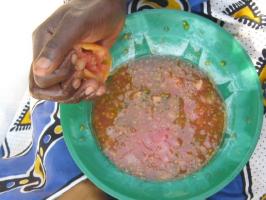 |
| Tomato seed extraction by smallholder farmers |
| © A.A. Seif, icipe |
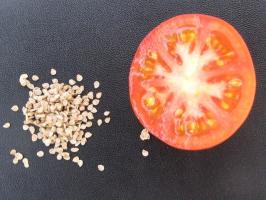 |
| Locally produced tomato seed |
| © A.A. Seif, icipe |
 |
| Storage of locally produced tomato seeds in plastic bag |
| © A.A. Seif, icipe |
Seeds can be stored, if properly dried, up to 2 years.
One kg of tomatoes will produce between 1 and 4 grams of seeds.
(This information is based on a Biovision Project carried out in Taita Hills, Kenya, under Eastern Arc Mountains in conjunction with Wild Life Services)
Nursery bed preparation:
- Construct raised seedbeds of maximum one m width in a place where no potatoes, tomatoes, eggplants or peppers have been grown for about 3 years.
- Incorporate about 5 kg of good compost/ m² into the seedbeds, which are finely cultivated on top.
- Drill shallow seeding furrows with a pointed stick. One ha of tomatoes requires 150 to 200 g of well germinating seed.
- Sow seeds in the furrows and cover them lightly with soil.
- Pat firmly with the flat side of a rake or similar tool, mulch and water liberally.
- Never use fresh manure on a seed bed as it will burn young seedlings.
- After emergence of seedlings push away the mulch from the rows to allow sunlight to get through to the young seedlings.
- Individual plant raising in banana leaf pots or plastic seedling trays will greatly improve eventual plant establishment, by reducing transplanting shock and root damage during transplanting.
- The young seedlings require sufficient water to sustain good, healthy growth.A week before transplanting, reduce watering to harden the seedlings. Three- to four-week-old seedlings (15 to 25 cm high with 3 to 5 true leaves) are ready for transplanting. Seedlings must be thoroughly watered 12 to 14 hours before they are lifted out of the seedbed, to avoid excessive damage to the roots. Transplant seedlings in the afternoon or on a still, cloudy day to reduce the transplanting shock, and water them immediately. As little as a cup of water per plant immediately at planting will greatly speed up plant establishment.
- Spacing between plants and distance between rows depends on the cultivar's growth habit and whether the plants are to be supported by stakes or left to grow on the ground.
- Indeterminate varieties are generally staked while determinate varieties can be grown in the field without staking. Common configurations are plants spaced 30 to 60 cm apart in single or double rows on 1.0 to 1.4 m wide beds.
Common Varieties available in Kenya and their yield potential (AIC 2003)
| Varieties for processing | Yield potential (tonnes/ha) |
| "Roma VF" | 83 |
| "Sun Marzano" | 100 |
| "Rutgers 10x Hybrid" | 100 |
| "Heinz 1350" | 60 |
| "Roma Nova" | 100 |
| "Cal J" | 73 |
| "M-82" | 57 |
| Varieties for fresh Market | Yield potential (tonnes/ha) |
| "Money Maker" | 20-50 |
| "Early Beauty" | 25 |
| "Super Marmande" | 85 |
| "Ponderosa" | 90 |
| "Hot Set" | 40 |
| "Best of all" | 100 |
| "Marglobe" | 90 |
| "BWN 21" | 90 |
| "Kenton F" | 32 |
| "Zawadi" | 30 |
| "Fortune Maker" | 30 |
Some varieties reported to be tolerant (T) or resistant (R) to pests and diseases available in east, central and southern Africa
| Variety | Bacterial wilt | Early blight | Fusarium and Verticilium wilt | Late blight | Red spider mites | Root-knot nematodes | Tomato Mosaic Virus | Tomato Yellow Leaf Curl Virus |
| "Alboran" | - | - | - | T | - | - | - | - |
| "Fortune" | R | - | R | - | - | - | - | - |
| "Maker" | - | - | - | - | - | - | - | - |
| "Kentom" | R | - | - | - | - | R | R | - |
| "Meru" | - | - | - | R | - | - | R | - |
| "Rio Grande" | - | R | R | R | - | - | - | - |
| "Roma VF" | - | - | R | - | - | - | - | - |
| "Roma VFN" | - | - | R | - | R | R | - | - |
| "Shengena" | - | - | - | R | - | R | R | - |
| "Taiwan F1" | R | - | - | - | - | - | - | - |
| "Tengeru 97" | - | - | R | R | - | R | R | R |
The breeding of new varieties of tropical cherry tomato varieties is continuing at the Asian Vegetable Research and Development Center (AVRDC) in Taiwan. All varieties available in Kenya so far are indeterminate and take 65 to 72 days to yield from date of transplanting. Cherry Tomatoes can typically produce for longer seasons than ordinary tomatoes due to their disease resistance or tolerance. The cultivars "Sugar Pearl" and "Girls Sweet" produce fruit that are prone to fruit cracking, so preferred varieties include "Tiny Tim", "Super Sweet 100F1", "Cherry King F1", "Cherry Sweet 100F1", "Sweetie" etc. Note that varieties with the added F1 on their name are hybrids, and seed collection from these may not produce as well as the bought seed. However "Tiny Tim" and "Sweetie" are open pollinated, and farmers could propagate seed from the best plants with good results.
Staking: For tall growing indeterminate varieties, put a 2 m stake firmly in the ground for each tomato plant and tie the stems loosely as the plant grows. Alternatively put a stout pole in the ground at every four m and two wires run - 1 at 2 m and another one at 0,15 m above the ground. Tye a fairly strong string between the two wires behind each tomato plant. The plants can then be carefully twisted around the strings as they grow.
Pruning of tomato plants is necessary for indeterminate varieties. One or two main stems should be allowed to grow and the side branches (laterals) pinched off as the crop grown on a weekly basis. When 6 to 8 flower clusters are formed, the growing top should be pinched off to encourage the growth of good size marketable fruit. Leaves close to the ground should be removed to help prevent entry of blight infection. No pruning and regulation of fruit number and clusters are normally practised on determinate cultivars. Semi-determinate cultivars may be grown either as a determinate or indeterminate crop. Smokers should wash their hands carefully with soap before handling tomato plants as they may otherwise transmit tobacco mosaic virus disease.
Tomatoes need adequate irrigation during the early plant growth, fruit set and fruit enlargement stages. Consistency of water supply to the plants plays a major role in attaining uniform maturity. It also reduces the incidence of blossom-end rot, a physiological disorder normally attributed to calcium deficiency during fruit enlargement. In dry weather watering is essential at least two times a week. Drip irrigation is the most efficient and risk free method of irrigation, as it does not create water splashes onto the plants.
Cherry tomatoes although indeterminate can produce quite well even when not staked in the field, but must then be given adequate space as they spread quite extensively ( one m² per plant is minimum). Higher production and easier field management are benefits of the expensive staking procedure.
After picking, tomatoes should be stored in a shady place either in the field or at home to prepare them for the market. Properly sorted and graded fruits generally command a better market price than ungraded fruits. The marketable fruits are then packaged in suitable containers, often 20-kg wooden boxes, bamboo baskets, plastic boxes, or other locally available packaging materials. Proper packaging protects fruits from injury and reduces water loss. The storage life of tomatoes depends on the maturity stage at which they are harvested and on the desired quality of fruits. Quality is highest when completely ripe, whether artificially or on the plant. Ideally mature-green tomatoes should be stored for 7 to 10 days at 13 to 18°C at 85 to 90% RH so that they will ripen properly. Colour is the single most important visual parameter of tomato quality. Lycopene development at temperatures above 30°C is generally poor. This is the main reason that tomatoes grown in the hot tropics tend to have a pale red or yellowish colour and are poorly flavoured.
Harvesting and packaging of cherry tomatoes depend on market requirements. For distant markets, the fruit clusters may be cut when the fruits start turning to a red or pink colour depending on the cultivar. Firm red ripe fruits are required for the domestic market. However for the export market, cherry tomatoes are graded and packaged into pre-packs before shipment direct to supermarkets in the export destinations. On the whole a marketable yield of 20 tons /ha and above is considered a good yield. Yield of up to 60 tons/ha have been obtained under experimental conditions at KARI,Thika Horticultural Research Station.
|
|
The main tomato pests in east and southern Africa are red spider mites and russet mites, fruitworms, whiteflies, leafminers and thrips.
Cutworms (Agrotis spp)
Cutworms are the caterpillars of certain moths. They are serious pests of tomato seedlings. They cut stems of newly transplanted or emerged plants at the base. Cutworm damage is more critical after thinning or transplanting.
- Eliminate weeds early, at least 2 weeks before transplanting.
- Plough and harrow the field prior to transplanting. This exposes cutworms to natural enemies and desiccation and helps destroy plant residue that could harbour cutworms.
- Make barriers to protect the transplanted seedlings. Barriers can be made by wrapping paper, aluminium foil, thin cardboard or similar materials around the base of transplant stems. Toilet rolls are handy as cutworm collars since they are readily available and will biodegrade into the soil.
- Dig near damaged seedlings and destroy cutworms.
- Conserve natural enemies. Parasitic wasps and ants are important in natural control of cutworms.

Cutworms Agrotis spp) on tomato. Note cut seedling. Early instars are about 7 to 12 mm long. Fully grown caterpillars are 35 to 50 mm long.
© A. M. Varela, icipe
Aphids (Aphis gossypii, Myzus persicae)
Aphids such as cotton aphid (Aphis gossypii) and the green peach aphid (Myzus persicae) suck plant sap, which can reduce plant growth; they also secrete honeydew, on which sooty moulds growth. Sooty mould on fruits reduces their market value. These aphids may also transmit virus diseases during feeding such as the cucumber mosaic virus. In Kenya, aphids are occasionally found on tomatoes, but they are not considered an important pest.
- Conserve natural enemies. Aphids are usually kept under control by a wide range of natural enemies. In particular, avoid use of wide spectrum pesticides since they kill natural enemies.
- Use reflective mulch. Reflective aluminium mulches deter aphids from landing on plants. The effect is lost once plants are large enough to cover the mulch.

Green peach aphid (Myzus persicae). Adult wingless females are 1.2-2.1 mm in body length and very variable in colour.
© Whitney Cranshaw, Colorado State University, Bugwood.org
Root-knot nematodes (Meloidogyne spp.)
Root-knot nematodes are very destructive to tomatoes. Damage is most serious on light sandy soils in furrow-irrigated crops. The nematodes cause small lumps known as root knots or galls on the roots. Heavily infected roots are severely distorted and swollen. In time the roots rot. The affected plants are either stunted or have tendency to wilt or even die in hot weather. The affected plants, in most cases, just wilt with the foliage still green - without yellowing. The nematode problem is primarily due to improper crop rotation.
- Rotate with tomato, brassicas or cereals.
- Do not locate seedbeds where susceptible vegetables (e.g. okra, sweet pepper, eggplant, Irish potato, carrot or cucurbits) have been previously grown.
- Use tolerant or resistant tomato varieties (e.g. "Roma VNF", "Shengena","Tengeru-97", "Kentom", "Caracas", "Carmello", "Diego", "Piersol" and "Vegas"). Varieties with the "VFN" label exhibit some resistance - the "N" stands for Nematode-tolerant.
- Use mixed cropping or grow marigolds (Tagetes spp.) or sunnhemp (Crotalaria juncea).
- Maintain high levels of organic matter in the soil (manure and compost).
- Amend the soil with neem. Mixing neem cake (residue of neem seed after expression of neem oil) increases the organic content of the soil and kills nematodes due to the naturally-occurring nematicidal compounds in neem.
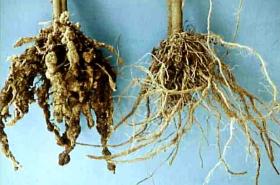
Root-knot nematodes (Meloidogyne incognita / M. javanica) Roots of severely attacked (left) and healthy plant (right). Affected plants are normally stunted and eventually wilt and die. The most characteristic symptom is formation of root galls (knots) and these can be seen with the naked eye. Affected roots rot.
© A. M. Varela, icipe
Weeds
Soil solarisation can provide control of many soil-borne diseases, nematodes, and weeds. Preventing weeds from producing seed helps reduce weed populations in subsequent crops; this also applies to areas adjacent to the cropped fields. A soil cap (5 to 10 cm mound of soil) over the seedline at planting can reduce the first flush of weeds competing with the crop seedlings. The cap is removed just after tomato seedlings germinate, but before rapid elongation of the hypocotyls. This mound also reduces soil moisture loss and emergence problems that result from soil crusting after periods of rainfall, and is formed by disks or other implements.
When tomato seedlings are about 10 cm tall, cultivation can create a dry layer of soil (dry mulch) on the seedline to prevent weed seeds from germinating and to smother small weeds that have already emerged. Flaming is also used for weed control in large-scale commercial tomato production.
- Crop rotation can effectively reduce difficult weed problems by altering the environmental conditions that favour a particular weed species or by permitting the use of alternative methods to control these weeds. Lucerne is a good choice for a rotational crop because its frequent cutting cycle reduces many weeds. Maize is also used in rotations with tomato as it is not a host to tomato diseases and weeds can be controlled in this crop.
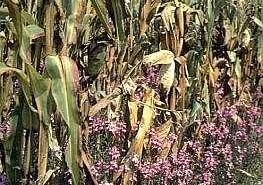
Striga (Striga hermonthica) weeds in maize field.
© Courtesy EcoPort (http://www.ecoport.org): David C. Nowell
The tobacco whitefly (Bemisia tabaci)
Tobacco whitefly is a serious pest of tomatoes. Whiteflies attack tomatoes from seedling to mature stage. They suck sap from the leaves, and may weaken the plants. Feeding of whiteflies cause yellowing of infested leaves. Immature stages (nymphs) produce honeydew on which sooty mould grows. Heavy honeydew or mould coating reduces plant growth and fruit quality.
The main damage caused by whiteflies is indirect as vectors of virus diseases. Bemisia tabaci transmits several virus diseases in tomato. In particular it is an efficient vector of the Tomato Yellow Leaf Curl Virus (TYLCV), a major disease in Kenya.
Small numbers of whiteflies do not cause major direct plant damage. However, even small numbers of whiteflies may need to be controlled in areas where TYLCV is common.
- Time sowing and transplanting. If possible avoid the season when whiteflies are more likely to occur.
- Use cover crops (forage, peanut, weeds) and inert covers (silver, yellow, and white/black plastic mulches). They have been shown to reduce whitefly damage in tomatoes. Whiteflies are attracted by the colour of the plastic mulch. The heat of the plastic kills the whiteflies. However, this is effective as long as the plants are young and do not cover the mulch. The protection can last for 10 to 20 days after transplanting and about 30 days after direct seeding. Take care to avoid sunscald when using plastic covers.
- Prevent physical contact of the whiteflies with the plant; this can prevent the transmission of viral diseases. Cover tomato seedling nurseries with nylon nets or use tunnels for 3 to 5 weeks to protect seedlings from whiteflies infestation. These methods have been reported to reduce the transmission of the Tomato Yellow Leaf Curl Virus in several countries.
- Conserve natural enemies. Whiteflies are mainly attacked by parasitic wasps and by predators such as phytoseiid mites, lacewings and ladybird beetles. For more information on natural enemies click here
- Check the crop regularly. Use yellow sticky traps to monitor the presence of whitefly adults. Yellow traps are also an effective control method of whitefly at low infestations. For more information on traps click here
- Remove weeds in advance of planting tomatoes, and keep tomato fields weed-free. Weeds play an important role in harbouring whiteflies between crop plantings. They also often harbour whitefly-transmitted viruses.
- If necessary spray neem extracts. Neem-based insecticides are reported to substantially reduce egg laying by B. tabaci, inhibit the growth and development of nymphs, and significantly reduce the risk of TYLCV transmission.
- Spraying with soap and water solutions reportedly controls whiteflies. The amount of soap needed depends upon the soap type. For more information on soap spray click here
- Plant barrier crops. Fenugreek and coriander are reported to repel whiteflies.
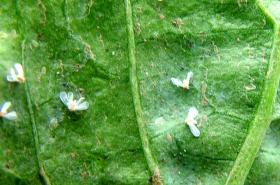
Whiteflies on chilli leaf. Adults are about 1mm long.
© B. Nyambo, A. A. Seif, icipe
Thrips (Thrips tabaci, Frankliniella occidentalis, F. schultzeii and Ceratothripoides brunneus)
Thrips may also be a problem in tomatoes in Kenya. Thrips are small (about 1 to 2 mm long). They usually feed on the lower surface of leaves puncturing them and suck the exuding sap. They also attack buds, flowers and fruits. Attacked leaves have a silvery sheen and show small black spots (thrips excrements). Under heavy infestation attacked buds, and flowers usually fall off. Attacked fruits show speckling and small necrotic patches on the surface affecting fruit quality. Fruits may become deformed.
Thrips feed on tomatoes at all stages, but their feeding on seedlings is particularly damaging. Heavy infestation can reduce stands of young seedlings in hot weather. Thrips of the genus Thrips and Frankliniella are vectors of viruses such as the Tomato Spotted Wilt Virus (the most economically important virus in tomato production) and the Tomato Chlorotic Spot Virus.
- Conserve natural enemies. Predatory mites (eg. Amblyseius sp.), anthocorid bugs (e.g. Orius spp.), and other predators such as ladybird beetles, lacewings and spiders, and the fungus Entomophthora are important in natural control of thrips.
- Monitor the crop regularly. Check plants daily in the nursery, and crop borders in the field. Be particularly vigilant at flowering. Pay careful attention to flowers and flower buds.
- Destroy thrips pupae in the soil. This helps reducing subsequent thrips populations. Plough and harrow before transplanting to expose pupae in the soil from previously infested crops to natural enemies and desiccation. Soil solarisation and flood irrigation (flooding previously infested fields prior to planting/transplanting) destroy a large proportion of thrips pupae present in the soil. For more information on solarisation click here
- If necessary spray biopesticides. Neem and some other plant extracts are reported to control thrips. Spinosad, a bacterial derivative is effective in thrips control. However, timing of biopesticide application is important. Thrips are difficult to control with insecticides due to their secretive habits (eggs are laid in plant tissue, the larvae and adult shelter in the flowers and larvae pupate in the soil). Spraying early in the morning or in the evening and mixing the spray with a sugar solution (which attracts the thrips out of the flowers) are reported to increase efficacy of sprays.

Thrips damage on tomato. Thrips are small (about 1 to 2 mm long)
© A.M. Varela, icipe

Thrips

Thrips

Thrips
Leafminers (Liriomyza spp.)
Leafmining flies make tiny punctures on the side of tomato leaves when feeding and laying eggs. These punctures may serve as entry point for disease causing organisms such as bacteria and fungi.
The most destructive stages are the immature stages (maggots). Maggots measure up to 3 mm in length. The maggots feed on leaf tissue inside the leaf leaving a wandering track in the form of irregular mines. Heavy mining of leaves may reduce photosynthesis affecting development of flowers and fruits. Heavy attack may cause leaf drop. This is particularly serious for tomato seedlings which may die due to defoliation. Defoliation of tomato plants may also expose fruits to sunburn and affect the market value.
Leafminers attack a wide range of cultivated vegetables.
- Conserve natural enemies. Parasitic wasps normally control leafminers. However, the widespread indiscriminate use of persistent broad-spectrum insecticides, to control this and other pests, disrupt the natural control, leading to leafminer outbreaks.
- Rotate with non-host crops and plan the arrangement of fields so that old infested fields do not provide a reservoir of infestation for subsequent crops.
- Destroy leafminer pupae in the soil. This can be done by ploughing and tilling, by solarisation, and, on heavy soils, by flood irrigation.
- Monitor the crop by checking foliage for the presence of stipples caused by the adults while feeding and laying eggs, and for mines and larvae. Trap adult flies with yellow sticky or water traps. For more information on traps click here.
- If necessary spray with neem-based pesticides. For more information on neem-based pesticides click here.
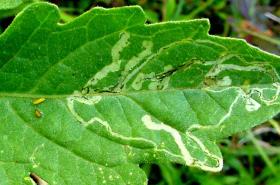
Damage by leafmining flies (Liriomyza spp.) on tomato leaf. Note maggot ready to pupate (yellow) and pupa (brown).
© A. M. Varela, icipe
Fruit borers (Helicoverpa armiguera, Spodoptera littoralis)
Fruit borers such as the African bollworm (Helicoverpa armigera) and leaf-eating caterpillars such as the cotton leafworm (Spodoptera littoralis) attack the developing and mature fruit of tomato. The African bollworm, also known as the tomato fruit worm, is one of the most destructive insect pests of tomato, causing yield losses as high as 70% due to fruit boring. They usually bore into the fruit from the stem end, and feed on the inner parts of the fruits, causing extensive fruit damage and promoting decay caused by secondary infections.
They prefer green fruit. Caterpillar of the cotton leaf worm feeds on the leaves of tomato and bores into the fruit, especially those growing down the plant near to the soil. They are olive-green, dark grey or brown in colour with large, black, triangular spots on their back. The fully-grown caterpillars are 3 to 5 cm long. The eggs are laid in batches in one or more layers, usually on the underside of the leaves and covered with hairs. Both caterpillars have many natural enemies such as predatory ants, spiders, damsel and robber flies, and parasitic wasps and flies
- Avoid planting tomato near maize or cotton to prevent heavy pest infestations.
- Monitor the crop regularly. Detection of eggs and small caterpillars before they enter into the fruit is very important. Once the caterpillars have entered the fruit they are protected from insecticidal sprays and will have caused damage. Check also for natural enemies and parasitised eggs. Healthy eggs are white with a reddish ring, but they turn black when parasitised. It has been recommended to randomly select 30 tomato plants and examine the leaves immediately below the topmost open flowers to look for eggs of African bollworm (AVRDC, 2000).
- Conserve natural enemies. A very rich variety of natural enemies of fruit borers have been recorded. The most important are parasitic wasps (egg and larval parasitoids) and predators such as anthocorid bugs, ants, lacewings and ladybird beetles. Although these natural enemies cannot always prevent economic damage, they play a significant role in controlling the pest populations. For more information on natural enemies click here.
- Spray selective biopesticides such as Bt or neem extracts. Pyrethrin and rotenone are also used for control of this pest, but they are harmful to natural enemies and not allowed in organic agriculture. Control measures should start when more than five healthy eggs are found or when large numbers of small caterpillars are found on leaves. For more information on neem click here. For information on Bt click here
- Hand pick and destroy eggs and caterpillars. This helps when their numbers are low and in small fields.
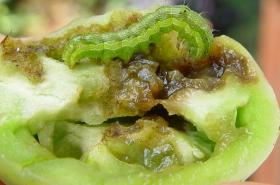
The african bollworm or tomato fruitworm (Helicoverpa armiguera) feeding on tomato fruit
© A. M. Varela, icipe

African bo…

African bo…

Cotton lea…
Spider mites (Tetranychus spp.)
Spider mites are important pests of tomatoes. They are more prevalent in dry areas. Infested leaves show a white to yellow speckling and then turn pale or bronzed. High spider mite infestation causes defoliation, which leads to production of smaller fruits with lower content of ascorbic acid (vitamin C). Spider mite feeding on fruits causes speckling of the fruits.
The tobacco spider mite Tetranychus evansi, is one of the most damaging spider mites on tomato. This spider mite can kill plants very rapidly under hot and dry conditions. Plants with high numbers of this mite can be covered with webbing and an orange cloud of mites.
- Conserve natural enemies. Natural occurring predators are in many cases capable of controlling the two-spotted spider mite and the carmine red spider mite. However, this is not the case for the tobacco spider mite. There are few predators known to feed on this mite. In Kenya, ICIPE has released predatory mites for control of the tobacco spider mite in early 2007.
- Inspect the crop regularly to determine the presence and level of infestation of spider mites. A recommended monitoring method is to select randomly 20 tomato plants and access the level of mite damage of three leaflets per plant using a leaf index ranking from 1 to 5 (1 is few yellow spots, 5 is leaf totally covered with spots, dry patches occur). Once the average damage level excess the first rank, control measures should start.
- When detected early, initial infestations are usually concentrated on a few plants, in many cases in the borders of the field. In this situation, remove and burn or bury infested plants to prevent the problem from spreading and becoming serious.
- Since mite populations are initially restricted to some plants, spot spraying (spraying only attacked plants) is usually effective.
- Avoid the use of broad-spectrum insecticides. They may kill natural enemies. In addition some synthetic pyrethroids can actually enhance spider mite reproduction leading to mite outbreaks. Spraying neem extracts, soapy solutions and water are reported to help control red spider mites. For more information on spider mites click here
- Avoid water stress. If necessary, irrigate the crop regularly, and apply mulch to reduce water evaporation
- Practise good field sanitation to minimise the risk of infestation. Keep the field free from weeds, remove and burn or compost crop residues immediately after harvest.
- Avoid planting new crops next to an already infested field (tomato or other crops).
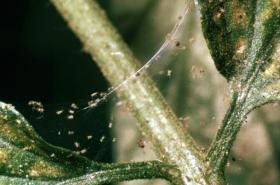
Spider mites on tomato. Note the mites and their webbing visible beetween the leaves.
© Clemson University - USDA Cooperative Extension Slide Series, Bugwood.org

Spider mit…

Spider mit…

Spider mit…
The tomato mirid bug (Nesidiocoris tenuis)
It is slender, greenish in colour with a dark brown tint on the forewings. Eggs are laid singly on the growing points, petioles and stems of the tomato plant. The young bugs (nymphs) resemble the adults, but initially have no wings. Older nymphs have wing pads. The tomato bug feed on stems, leaves and flowers of tomatoes, but prefer young leaves and growing points. Sucking by nymphs and adults results in the formation of brownish rings on stems, petioles, growing points and leaf veins, which become brittle. Repeated feeding by the bugs cause crinkling (rolling, puckering and unevenness) of leaves.
Attacked stem bases become swollen with narrow brownish rings at the apices of the swollen areas. Shedding of flowers may be partly due to feeding by this bug. Other major crops attacked include eggplant, sesame and bottle gourds. The tomato bug also exhibits predatory habits, and has been reported preying on other insect pests, such as aphids, jassids (leafhoppers), caterpillars and whiteflies. It has been identified as an important predator of eggs and young caterpillars of the African bollworm and a potential control agent of whiteflies in Europe. This bug was found frequently and in large numbers on tomatoes, throughout NE and NW Somalia (Seif et al. 2003). It has also been reported as a tomato pest in Ghana (Youdeowei, 2002). In Kenya, large numbers of this bug have been observed in tomato fields under heavy and frequent spraying of synthetic pyrethroids.
- Inspect crops for nymphs and adults feeding on buds, developing flowers and leaves, and for signs of bug feeding, including discoloured spots, necrosis, stunting, and early fall of flowers and fruits.
- Avoid volunteer crops.
- Assure proper disposal of crop residues.
- Avoid indiscriminate use of broad-spectrum pesticides
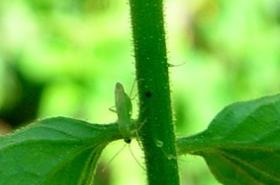
Tomato bug adult (Nesidiocoris tenuis) on tomato plant, they are about 4mm long
© A. M. Varela, icipe

Tomato mir…

Tomato mir…
The tomato russet mite (Aculops lycopersici)
They are very tiny, approximately 0.2 mm long, and cannot be seen with the naked eye. They are yellowish, brown or pink. They have a ringed conical body with the head and two pairs of legs at the large end. They complete the lifecycle in 1 week; this explains the rapid increase of this mite in tomato fields. They prefer high temperatures and low humidity. They feed on all above-ground parts of the tomato plant, causing spotting, twisting or folding of leaves and fine cracks on the fruits. Attacked leaves and stems develop a greasy appearance and turn bronzed. The plants can drop their leaves, especially in hot weather. Fruits are then exposed to sunburn. Damage to the plant typically begins near the ground and spreads upwards. Damage can develop very rapidly, and the mites can kill plants in a few days in dry hot weather. Since the mite cannot be seen, the symptoms are easily confused with diseases. The small size of the mites makes monitoring difficult. The first signs of mite presence are the curling and bronzing of the lower leaves of the stem.
- Conserve natural enemies. Few natural enemies of the tomato russet mite are known. Predatory mites are considered to be the most important natural enemies. However, the effect of these natural enemies is hampered by extensive use of pesticides.
- Spray neem extracts. Neem oil and aqueous neem kernel have been reported to give good control of this mite in Costa Rica. For more information on neem extracts click here.
- Ensure proper irrigation during early stages of the crop. This can help prevent mite build-up later in the growing season since tomato russet mite infestation is higher on tomato plants under water stress.
- No resistant varieties are available. In Kenya, tolerance to leaf damage was observed in two varieties, namely "Early Stone" and "Beauty".

Damage on tomato fruit and leaves caused by the Tomato russet mite, Aculops lycopersici
© Courtesy EcoPort (http://www.ecoport.org): L. Steynberg
The cabbage looper (Trichoplusia ni)
In addition to the cotton leaf worm (see fruit borers), other caterpillars such as the cabbage looper (Trichoplusia ni) feed on tomato leaves. However, generally they are not of economic importance.
The cabbage looper is a green caterpillar with faint white stripes along the body. Caterpillars are about 3.5 to 4 cm long when fully-grown. As they move, they arch their back in a looping fashion, hence the common name looper. Larvae (caterpillars) chew holes in the leaves, and larger caterpillars consume great amounts of plant material.
The adult is a moth, about 2.5 cm in length and mottled, greyish-brown.
- Conserve natural enemies. These caterpillars are attacked by a large numbers of natural enemies, including parasitic wasps and flies. Birds and bats feed on the adults (moths).
- Pick caterpillars by hand and destroy them.
- When control is necessary use biopesticides such as neem-based products or Bt. Neem products control cabbage looper by interfering with the growth of the young caterpillar. Bt and neem should be applied when caterpillars (larvae) are still in the early growth stages.
For more information on neem click here.
For more information on Bt click here.
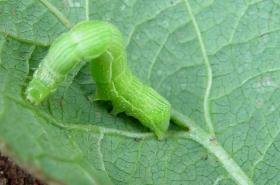
Cabbage looper (Trichoplusia ni) on cabbage. The first instar is white and almost clear with a black head capsule. Later instars are green with a thin white line on each side. Mature larvae reach 3 to 4 cm in length.
© A.M. Varela, icipe

Cabbage lo…

Cabbage lo…
 |
| Bacterial speck (Pseudomonas syringae pv. tomato) of tomato seedlings. Note the necrotic lesions and the widespread chlorosis. |
| © Courtesy EcoPort (http://www.ecoport.org): M.D. Laing |
The main diseases affecting tomatoes in the region are early blight, late blight, bacterial wilt, Fusarium wilt, bacterial canker and root-knot nematodes.
Other bacterial diseases of tomato include bacterial speck (Pseudomonas syringae pv. tomato), bacterial stem and fruit rot (Erwinia carotovora subsp. carotovora), and pith necrosis (Pseudomonas corrugata).
Other important fungal diseases of tomatoes are leaf mould (Mycovellosiella fulva) and powdery mildew (Leveillula taurica).
Recent surveys have shown that viral diseases are a major constraint to tomato production in Eastern and Southern Africa. Important virus diseases are Tomato yellow leaf curl virus, and more recently also Tomato spotted wilt virus.
Anthracnose (Colletotrichum coccodes)
Spots of fruits are sunken. When weather is moist, the spots get tan-coloured (growth of fungal spores). There may be several spots on affected fruit and they may join up and cover the whole fruit. Severely affected fruits drop. Eventually, affected fruits dry and become black. Most often, soft-rot bacteria invade affected fruits and cause a soft watery decay.
The fungus usually attacks fruits on plants that are weakened or over-ripe. Infection is favoured by relative humidity close to 100% and temperatures between 21 and 30° C.
- Use resistant varieties, if available.
- Use certified disease-free seeds.
- Practise crop rotation.
- Destroy infected crop residues.

Anthracnose (Colletotrichum coccodes) on tomato
© Clemson University - USDA Cooperative Extension Slide Series, www.insectimages.org (www.ecoport.org)
Bacterial wilt (Ralstonia solanacearum)
Bacterial wilt has often been reported as the most serious handicap for tomato in the tropics. The disease causes rapid wilting and death of the entire plant without any yellowing or spotting of leaves. Total collapse of the plant usually occurring when temperatures reach 32°C and above. Plant wilts while still green. When the stem of a wilting plant is cut across, the pith has a darkened water-soaked appearance, and on squeezing the cut stem, a white, yellow or greyish, slimy exudate may appear. In later stages of the disease, decay of the pith may cause extensive hollowing of the stem.
- If only a few wilted plants are found, immediately remove them from the field.
- Practise long-term crop rotation.
- A method called "bio-fumigation" is under development from the Australian Center for International Agricultural Research for the reduction and long-term elimination of bacterial diseases from the soil by incorporating especially mustard or radish plants in large amounts into the soil immediately before planting tomatoes or potatoes. This practice is reported to reduce incidence of bacterial wilt by 50-70% in the Philippines (ACIAR 2005/6). For more information on biofumigation click here
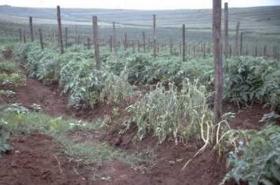
A row of tomatoes with individual plants infected with bacterial wilt (Ralstonia solanacearum). Note that the wilt often starts next to a trellising pole because the pathogen can overwinter on the pole. Tomatoes in South Africa are typically cultivated with wire trellising to hold up the plants.
© Courtesy of EcoPort, www.ecoport.org

Bacterial …

Bacterial …
Powdery mildew (Leveillula taurica)
The spots of powdery mildew appear on older leaves and are light chlorotic to bright yellow. These spots later run together and become necrotic. Whole leaf blades may collapse and dry up. On the upper leaf surface of green leaves, a fine talcum-like powder is observed. This is fungal growth.
- Keep tomato fields free of weeds.
- Do not grow brinjals (eggplant) or tomatoes in succession.
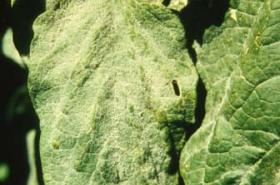
Powdery mildew on sesame (Erysiphe cichoracearum)
© Courtesy EcoPort (http://www.ecoport.org): Jürgen Kranz

Powdery mi…

Powdery mi…
Blossom-end rot
It is caused by calcium deficiency and irregular watering. The disease occurs at the blossom-end of the fruit. It starts as a water-soaked spot that enlarges to become dark brown and sunken. The surface of the spot becomes dark and leathery. The rot is dry.
- Avoid water stress during early stages of fruit development.
- Apply lime in calcium deficient soils.
- Apply foliar sprays of calcium chloride.
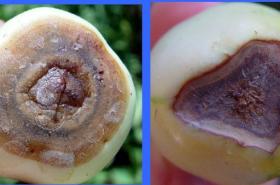
Stages of blossom-end rot
© A. M. Varela, icipe
Tomato yellow leaf curl virus
The virus is transmitted by whiteflies (Bemisia tabaci). It is not seed-borne. Tomato plants infected early in the season are normally stunted and excessively branched. Affected leaves are chlorotic and are curled upward. Flower drop is common, and therefore, infected plants have a reduced number of flowers and fruits.
- Use resistant or tolerant varieties such as "Tengeru 97", "Amareto", "Peto 86", "Fiona F1", "Perlina", "Denise", "Cheyenne" ("E448"), "Rover", "Roma" and "Marglobe" is highly susceptible and should not be used in areas where the disease is common.
- Protect seedbeds with a white nylon net (40 mesh), as the later the plants are infected with the virus the less impact the disease will have on yield reductions.
- Eradicate weeds.
- Rogue out diseased plants (in the seedbed and in the field) and destroy them.
- Plant barrier crops.
- Avoid continuous growing of tomato.
- Control whiteflies. For more information on whitefly control click here
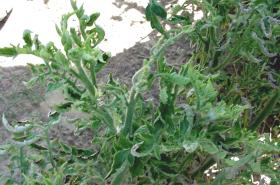
Tomato yellow leaf curl virus. Note thickened shoots.
© A.A. Seif, icipe
Tomato spotted wilt virus
The virus is transmitted by thrips (Thrips tabaci and Frankliniella spp.). The virus has a wide host range including many ornamental plants, vegetable crops and weeds. Diseased leaves have purplish-brown spots. Diseased leaves later turn brown, die and droop. Brown streaks occur on leaf petioles and stems. Infected plant becomes dwarfed, and with its drooping leaves, it resembles a plant affected by wilt. Symptoms on fruits consist of circular zones with shades of yellow or brown alternating with green and later with pink or red. Fruit symptoms are very characteristic of the disease.
- Plant resistant cultivars, (e.g. "Star 9006", "Star 9008")
- Control the insect vectors early.
- Practise general field sanitation.
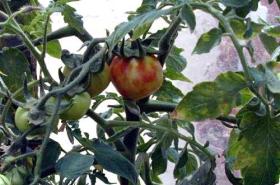
Tomato spotted wilt tospovirus: mottle in tomato fruit.
© Courtesy EcoPort (http://www.ecoport.org): Mike Pearson
Tomato Mosaic Virus
Affected plants show light and dark green mottling and distortion of the youngest leaves. The latter may be stunted or elongated resembling fern leaves. Under high temperature and light intensity, mottling can be severe. Under low temperature and low light intensity, stunting and leaf distortion are severe. Internal browning of the fruit sometimes occurs; this symptom is most common when fruits become infected at mature green or pink stage.
The disease can be seed-borne but can also survive on plant debris in the soil and so re-infect newly planted crops. The virus is easily mechanically transmissible by contact between plants or through human activities (transplanting seedlings or pruning).
- Use resistant varieties (e.g. "Alboran", "Kentom", "Meru", "Shengena", "Tengeru 97")
- Use certified disease-free seeds.
- Avoid an overlap of tomato crops.
- Do not use freshly harvested seeds.
- Remove crop refuse and roots from fields.
- Eradicate weeds.
- Workers should not smoke or take snuff when working in tomato fields since the virus can be transmitted from tobacco.

Tomaco mosaic virus. Note internal browing of the fruit.
© A. A. Seif and A. M. Varela, icipe
Bacterial spot (Xanthomonas campestris pv. vesicatoria)
It is another serious disease, occurring during the rainy season. It is most noticeable on fruits, but also causes damage to the foliage and stems. On green fruits, the initial spot is very small and water soaked. It eventually enlarges to about 6 mm. As the bacterial spot matures, it becomes brown and scabby without extending deep into the fruit. On foliage, irregular greasy, dark green spots, 2 to 3 mm wide, are observed. The spots eventually dry and the tissue often tears. The disease is transmitted through the seed.
- Use certified disease-free seed.
- Remove and destroy crop residues after harvest.
- Avoid working in the fields when plants are wet.
- Spray with copper fungicides; copper can control this disease fairly well except under heavy infection.
- Grow resistant cultivars; this is the best control method for both bacterial diseases, but resistance is not universal owing to variable strains of the pathogens.

Damage of Bacterial spot (Xanthomonas campestris pv. vesicatoria) on tomato leaf.
© Clemson University, www.insectimages.org

Bacterial …

Bacterial …

Bacterial canker (Clavibacter michiganensis subsp. michiganensis)
The first symptoms are yellowing, curling and wilting of the leaflets, often on one side of the leaf. The affected leaflets turn brown and dry but remain attached to the plant. The whole plant may also show a one-sided disease development. Long brown strips may appear on stems and shoots. These strips dry and crack open to form cankers from which the disease gets its name. When an affected stem is cut lengthwise, there is a creamy white, yellow or reddish-brown line inside the woody tissue. The pith is easily separated from the wood along this line.
The vascular bundles within the pith are destroyed and cavities are formed in the pith. Young affected fruits are small, deformed and seeds are aborted. Also spots may develop on older fruits. These spots are circular, up to three mm wide, with slightly raised brown centre surrounded by a pronounced white halo resembling a 'bird's eye". The halo is flat. The bacterium is seed-borne and can survive up to three years in soil in crop debris. Spread within a crop is by rain splash, sprinklers and pruning knives.
- Plant tolerant or resistant varieties, if available.
- Use certified disease-free seeds.
- Rotate seedbeds and tomato fields with non-solanaceous crops.
- Eradicate solanaceous weeds.
- Avoid sprinkler irrigation where the disease is endemic.
- Avoid working in tomato fields when it is wet.
- Disinfect pruning knives with commercial detergents between plants .

Birds eye symptoms on tomato caused by bacterial canker
© A.A. Seif, icipe
Damping-off diseases (Pythium spp. and Rhizoctonia solani)
Damping-off can occur when seedlings die before they have pushed through the soil, resulting in patches that appear to have germinated poorly. Alternatively, seedlings may emerge but fall over and die some time afterwards. The base of stem of affected seedlings become wet and brown. These disease-causing fungi are common in moist soils. They can also be transmitted on seeds.
- Use certified disease-free seeds. If it is farmer-saved seed, it can be given hot water treatment. For more information on hot water treatment click here .
- Do not site seedbed on a field previously planted with brinjals (eggplants), pepper, potatoes or tomatoes.
- Solarisation of seedbed should be done where feasible. For more information on solarisation click here .
- Avoid excessive watering.
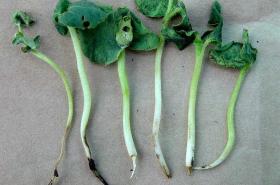
Okra seedlings affected by damping-off
© A.A. Seif & A.M. Varela, icipe
Fusarium wilt (Fusarium oxysporum sp. Lycopersici)
The lower leaves of the plant usually turn yellow and die. One or more branches may exhibit such symptoms. Leaflets on one side may be affected while those on the other side are symptomless. Diseased leaves readily break away from the stem. When affected stems just above ground level and petioles are cut diagonally, a reddish-brown discolouration of the water conducting tissues will be observed. The fungus is both seed- and soil-borne. It causes most damage on light, sandy soils. It is most active at temperatures between 25 and 320 C. The fungus can survive in the soil indefinitely even when no tomatoes are grown. It can also survive in fibrous roots of weeds (e.g. Amaranthus, Digitaria and Malva species). Acidic soils (pH 5.0 to 5.6) and excessive nitrogen fertilisation promote disease development. Infestation by root-knot nematodes encourages the disease.
- Use resistant tomato varieties (e.g. "Fortune Maker", "Rio Grande", "Tengeru 97", "Roma VFN").
- Use certified disease-free seeds.
- Do not locate seedbeds on land where Fusarium wilt is known to have occurred.
- Where soil is acidic, raise the pH by applying lime or farmyard manure.
- Avoid excessive nitrogen fertilisation and control root-knot nematodes.
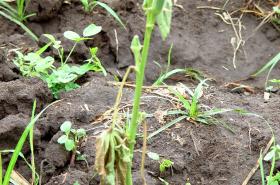
Wilting of okra plant due to fusarium wilt
© A.M. Varela & A.A.Seif, icipe
Early blight (Alternaria solani)
Leaf spots of early blight are circular, up to 12 mm in diameter, brown, and often show a circular pattern, which distinguishes this disease from other leaf spots on tomato.
- Use resistant varieties (e.g. "Rio Grande").
- Use certified disease-free seeds. If using own seeds, hot water treat the seeds. For more information on hot water treatment click here .
- Use disease-free plants.
- Do not plant plant consecutively tomato crops on the same land.
- Practise rotation with non-solanaceous crops (e.g. brassicas, legumes, small grains).
- Stake and prune indeterminate varieties.
- If disease is endemic, applied preventative sprays of copper compounds (e.g. copper hydroxide). For more information on copper click here.
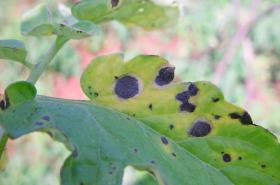
Early blight on tomato leaf. Note concentric rings in the spots.
© A. M. Varela, icipe

Early blig…

Early blig…
Late blight (Phytophthora infestans)
Symptoms of late blight are irregular, greenish-black, water soaked patches, which appear on the leaves. The spots soon turn brown and many of the affected leaves wither, yet frequently remain attached to the stem. Infection of the fruit occurs at any stage of growth. It is most common on the upper half of the fruit. The spots are greasy brown and have a firm corrugated (rough) surface that occasionally shows narrow zonate markings.
- Use resistant varieties (e.g. "Rio Grande", "Tengeru 97" etc).
- Use disease-free transplants.
- Stake and prune indeterminate varieties.
- Do not plant tomatoes after potatoes.
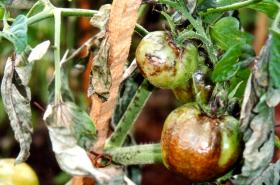
Late blight on tomatoes. Note scorched appearance of leaves, stems and fruits.
© B. Loehr, icipe

Late bligh…

Late bligh…
Leaf mould (Mycovellosiella fulva)
Symptoms of leaf mould are pale-green or yellowish areas with undefined margins that appear on the upper leaf surface. Under humid conditions the lower leaf surfaces of the spots become covered by an olive-green to greyish-purple velvety growth of the fungus.
- Prune and stake to reduce humidity.
- Avoid excessive shading by providing adequate plant and row spacing.
- Avoid wetting leaves when watering.
- ACIAR, "Partners in Research for Development" Magazine, Summer 2005/6. www.aciar.gov.au
- AIC (2000). Local and Export Vegetables Growing Manual. Nairobi Kenya
- AIC (2003). Fruits and Vegetables Technical Handbook. Nairobi, Kenya
- AVRDC. Tomato fruitworm. www.avrdc.org
- CAB International (2005). Crop Protection Compendium, 2005 Edition. Wallingford, UK www.cabi.org
- Dobson, H, Cooper, J., Manyangarirwa, W.,Karuma, J. and Chiimba, W. (2002). Integrated Vegetable Pest Management - Safe and sustainable protection of small-scale brassicas and tomatoes. Natural Resources Institute, University of Greenwich, UK ISBN: 0-85954-536-9
- East African Seed Co. Ltd. Africa's Best Grower's Guide www.easeed.com
- Nutrition Data www.nutritiondata.com.
- Seif, A. A., Varela, A. M. and Nyambo, B. (2003). Tomato pests and diseases in Somalia and their control. Edited by A. J. Harberd. Integrated Pest Management Project in Somalia. UNA IPM Project.
- Varela, A.M., Seif, A.A. and Loehr, L. (2003). A Guide to IPM in Tomato Production in Eastern and Southern Africa. ICIPE, Kenya. ISBN: 92 9064 149 5.
- Youdeowei, A. (2002). Integrated pest management practices for the production of vegetables. GTZ. Integrated Pest Management Extension Guide 4. Published by The Ministry of Food and Agriculture (MOFA) Plant Protection and Regulatory Services Directorate (PPRSD), Ghana with the German Development Cooperation (GTZ). ISBN: 9988-0-1088-5.
- Corner Shop, Nairobi cls@mitsuminet.com
- Food Network East Africa Ltdinfo@organic.co.ke +254 0721 100 001
- Green Dreamsadmin@organic.co.ke +254 0721 100 001
- Kalimoni Greens kalimonigreens@gmail,com +254 0722 509 829
- Karen Provision Stores karenstoresltd@yahoo.com +254 020885552
- Muthaiga Green Grocers
- Nakumatt Supermarket @nakumatt.net +254 020551809
- Uchumi Supermarket customerservice@uchumi.com +254550211
- Zuchinni Green Grocers +254 0204448240
